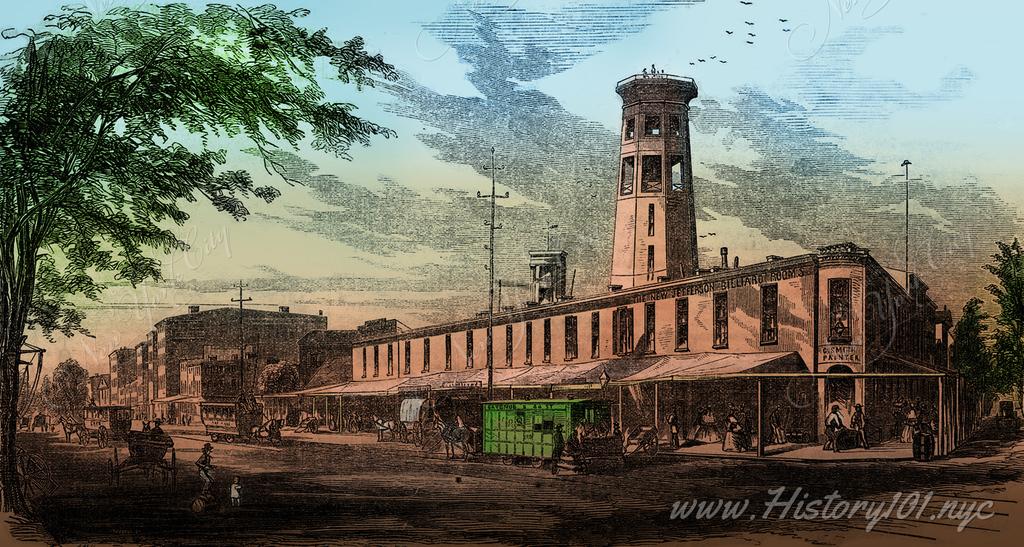
1850s NYC: Building a Global Metropolis, Infrastructure Expansion & Economic Surge
The 1850s marked a period of significant growth and transformation for New York City, paving the way for its rise as a global metropolis. During this decade, the city underwent both physical and cultural expansion, setting strong foundations for its future as a major urban center. A key development was the introduction of the Croton Aqueduct in 1842, which became fully operational in the 1850s. This innovation revolutionized the city’s water supply, dramatically improving public health and sanitation.
Architecturally, the 1850s saw the construction of structures that would symbolize New York City’s ambition and growth. This period was characterized by the city’s territorial expansion, notably the incorporation of Brooklyn, which later became a borough. This expansion coincided with a substantial influx of immigrants, bringing diverse cultures and significantly enriching the city’s social tapestry.
Economically, the 1850s were a time of booming commerce and industry for New York City. The growth of the shipping industry, propelled by the city’s strategic position and the earlier opening of the Erie Canal, solidified New York as a crucial hub for both national and international trade. Concurrently, the financial sector flourished, with Wall Street emerging as a cornerstone of American finance.
In summary, the 1850s were years of dynamic change and development for New York City. The advancements in infrastructure, architecture, and economy during this era were instrumental in defining the city’s identity. The legacy of the 1850s remains a pivotal chapter in New York City’s history, exemplifying its transformation into one of the world’s most influential and diverse urban centers.
Timeline of New York City’s History 1850’s
Discover surprising historical facts about The City That Never Sleeps—explore fun, educational insights into its history, population, iconic landmarks, and more, perfect for students, history enthusiasts, and anyone curious about NYC’s rich heritage.
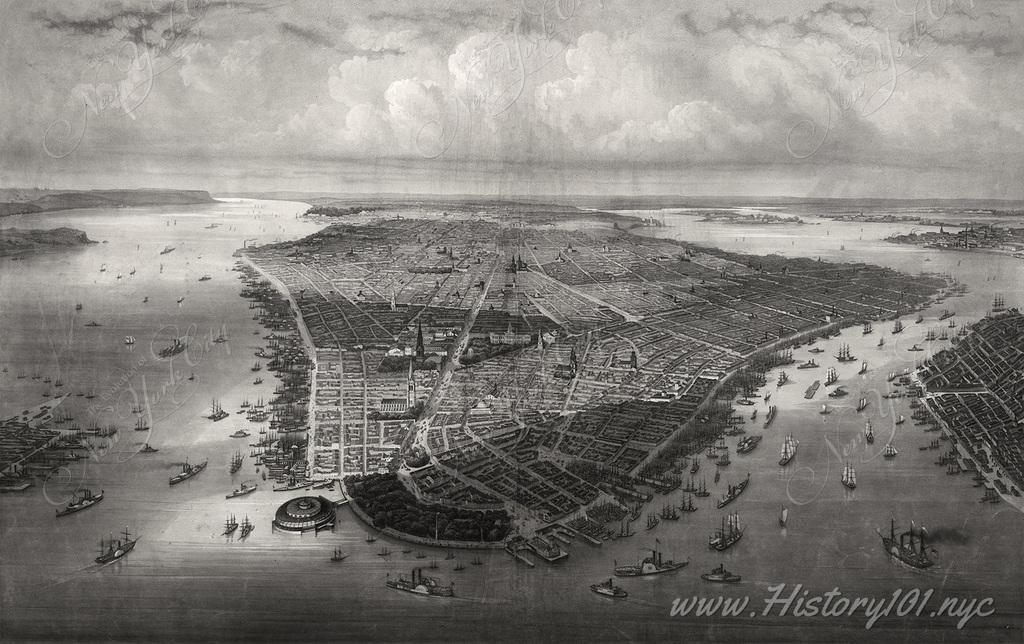
1851: Mid-19th Century “New-York” Engraving: A Bird’s-Eye View by Heine, Kummer & Himely
Explore this 1851 “New-York” engraving, a bird’s-eye view produced on stone (litho) by Heine, Kummer, and Himely, capturing Manhattan’s mid-19th-century growth
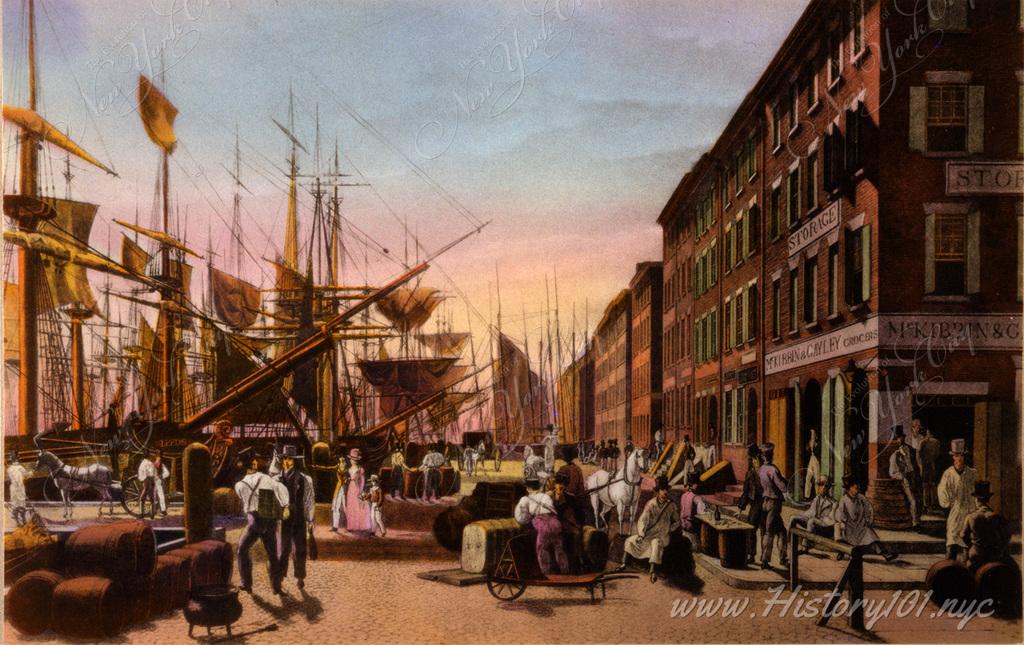
1850: Busy Scene at The South Street Seaport
Artist's rendering of The South Street Seaport, the first pier in the area was occupied in 1625 by the Dutch West India Company.
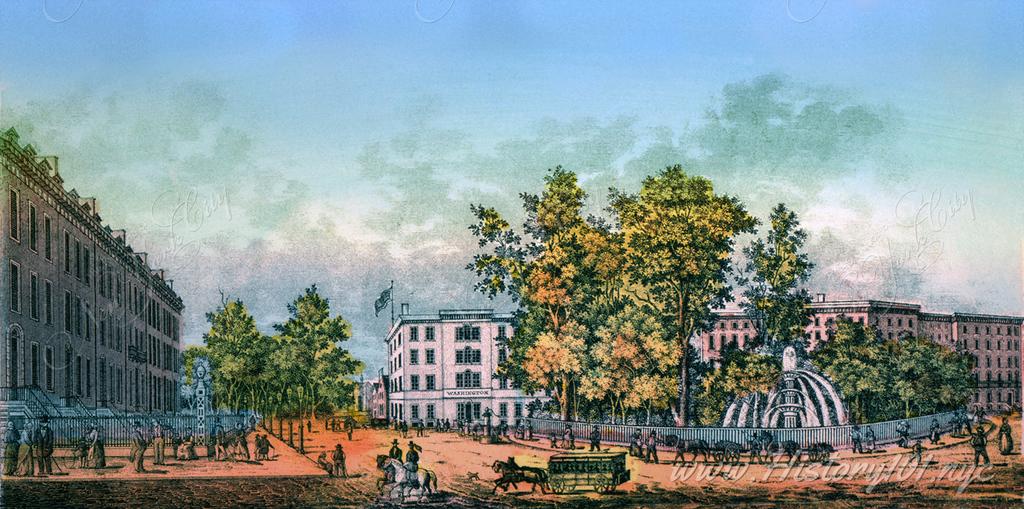
1850: Bowling Green Park
New York's oldest public park (formerly, there was a turf present for playing lawn bowling) which is also surrounded by the oldest fence in City.
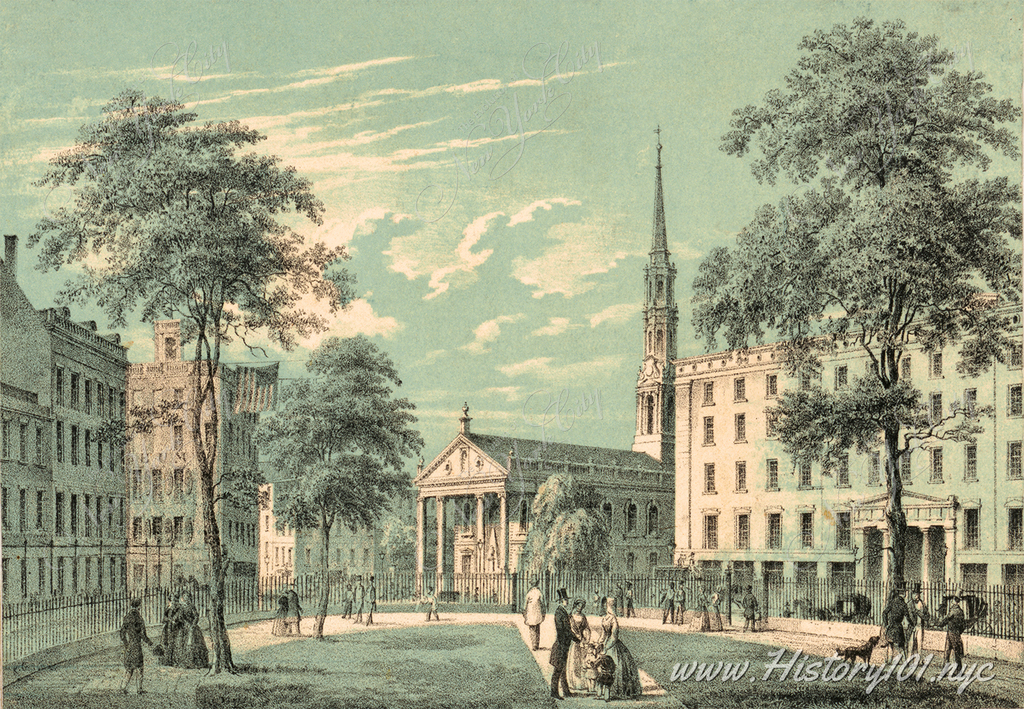
1850: Astor House Saint Pauls and Barnum
Print showing a street view from the park of St. Paul's Church, Barnum's Museum and the Astor House in New York City.
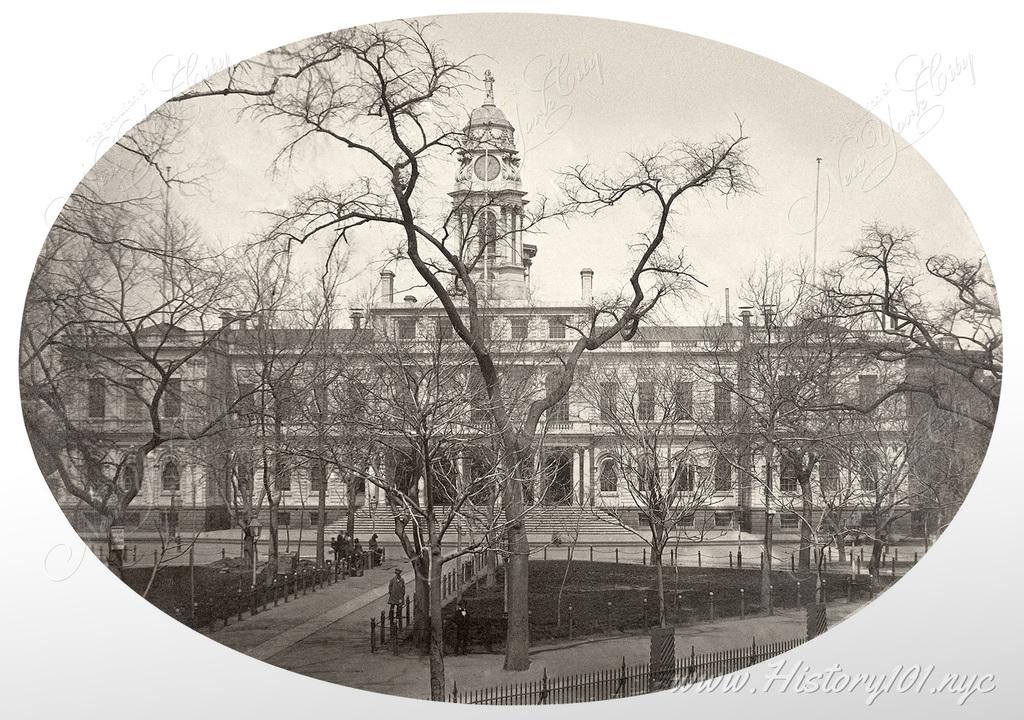
1855: City Hall, Manhattan
A photograph of Manhattan's City Hall. Taken by A.R. Waud in the winter of 1855.
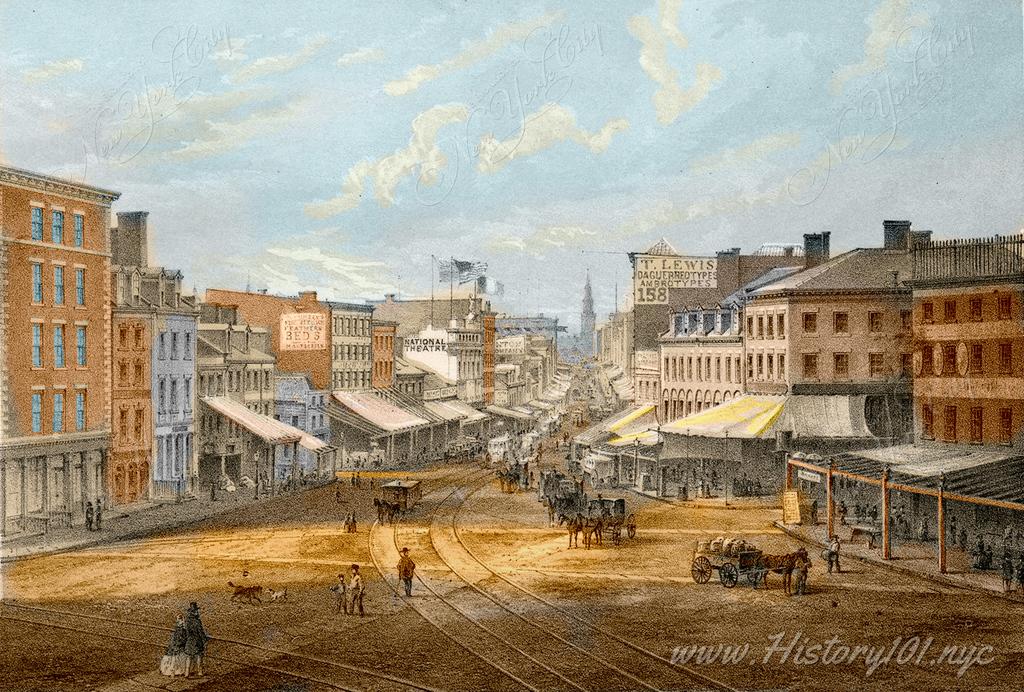
1858: Looking South from Chatham Square
Lithograph illustration of Chatham Square, named after William Pitt, 1st Earl of Chatham and Prime Minister of Great Britain before the American Revolution.
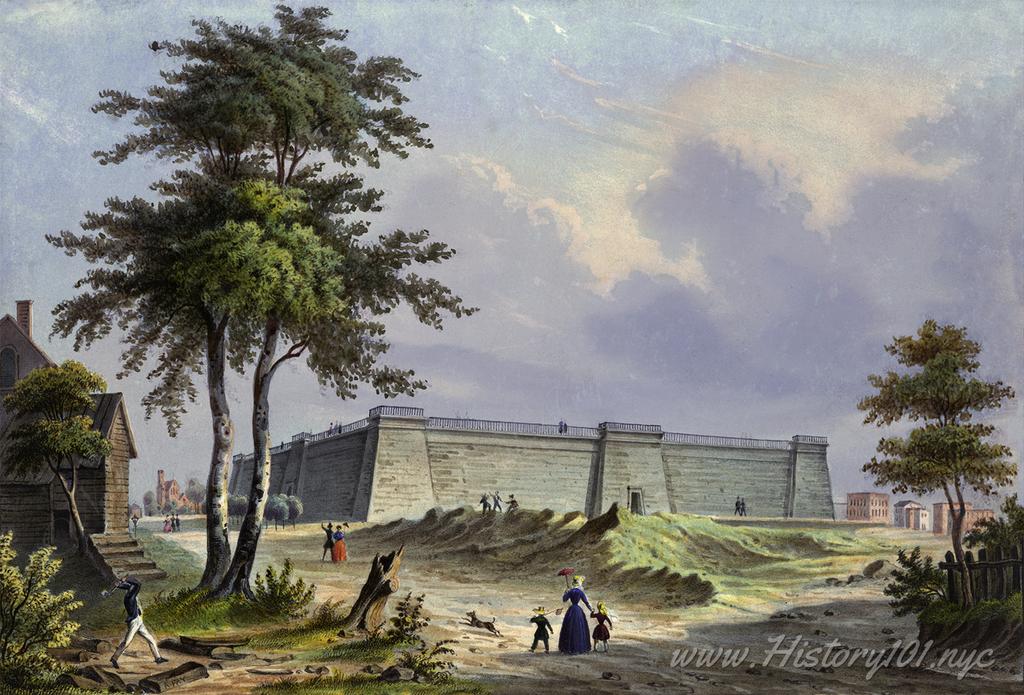
1850: The Croton Reservoir
Painting of the Croton Reservoir at 42nd Street. Completed in 1842, it was the source of the city's drinking water until its demolition in the 1890s.
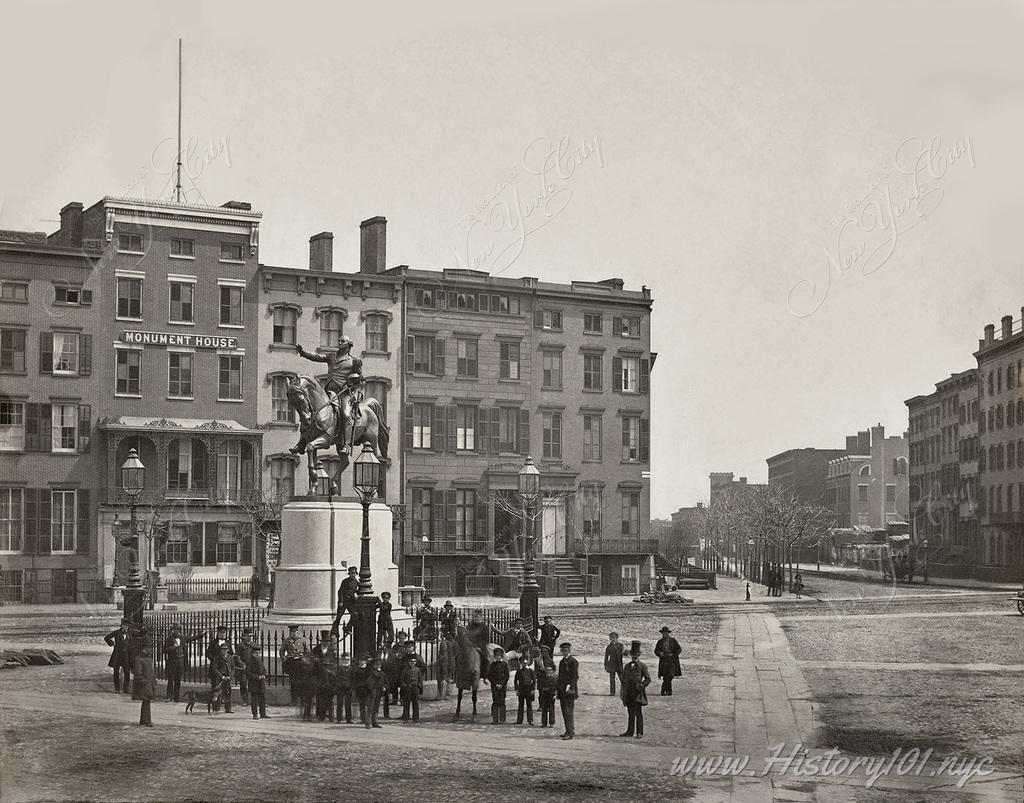
1855: George Washington Monument at Union Square
A group gathered around the newly constructed monument of George Washington in Union Square, dedicated in 1856 the the oldest sculpture in any NYC Park.
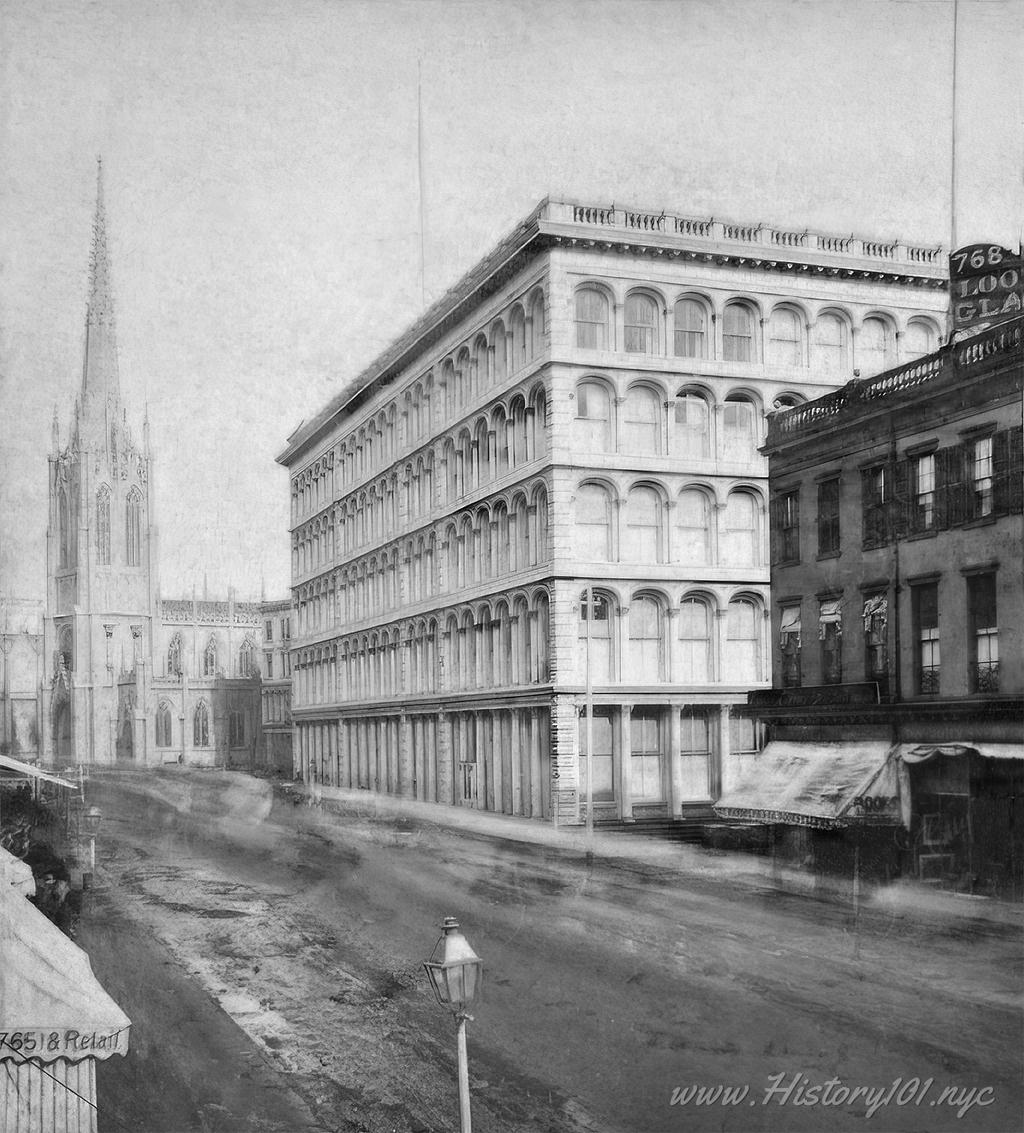
1850: Grace Church
Photograph of Broadway, looking north towards A.T. Stewart's Building and Grace Church.
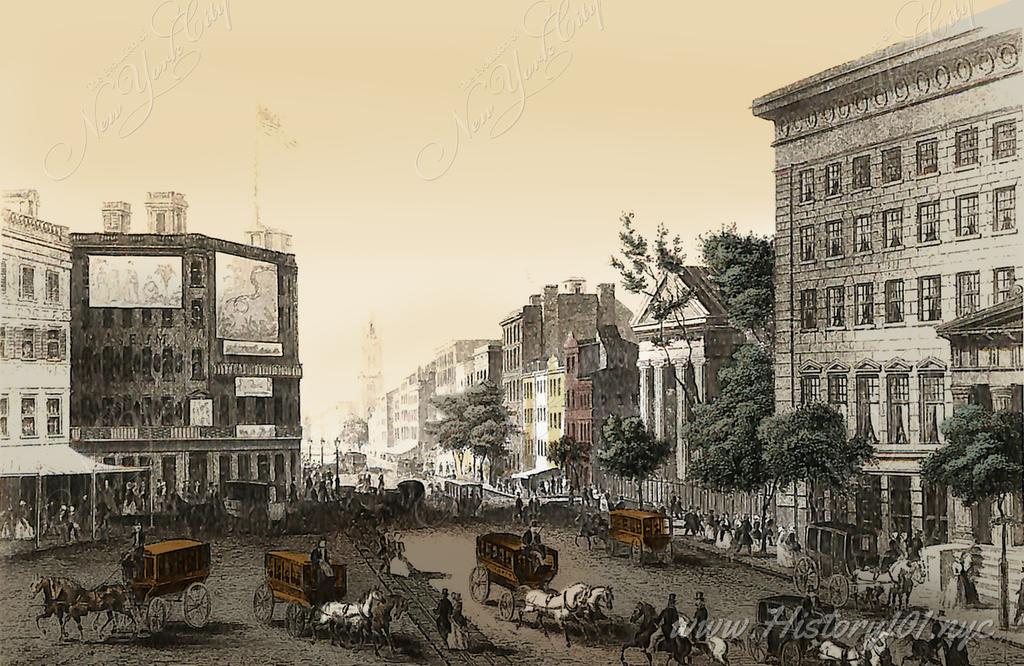
1855: Broadway and Vesey Street Looking South
Watercolor Illustration of Broadway and Vesey Street Looking South.
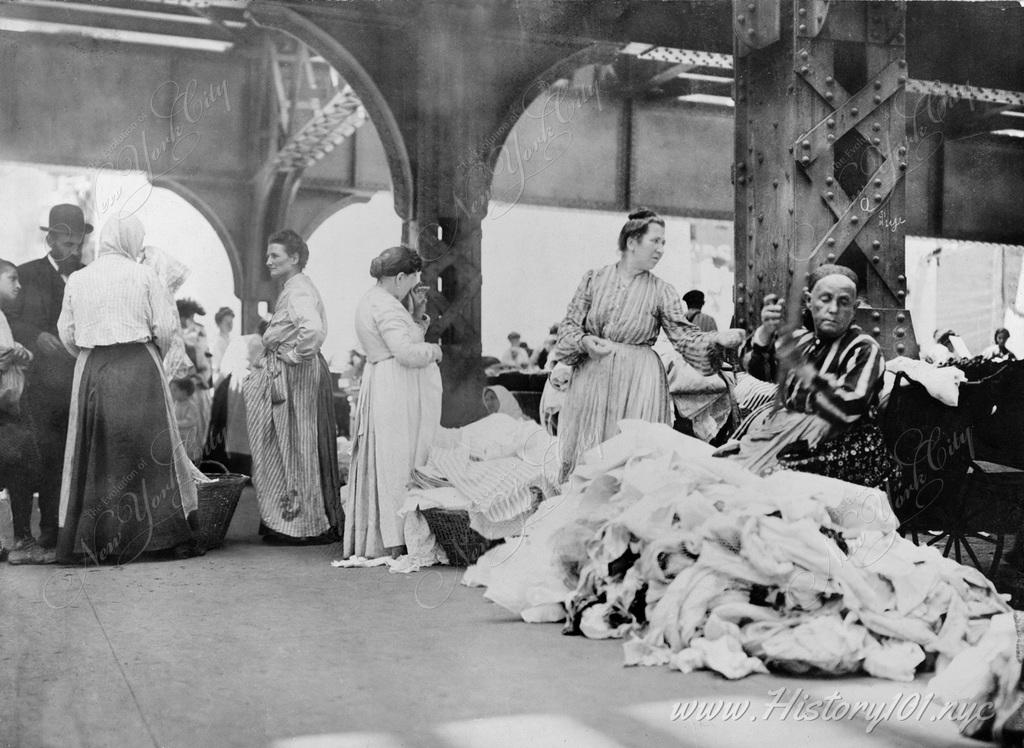
1850: The Rise of New York City as a Fashion and Garment Industry Powerhouse: 1820s to 1850s"
Discover how NYC transformed into a fashion hub, from immigrant craftsmanship in the 1820s to the 1850s sewing machine revolution
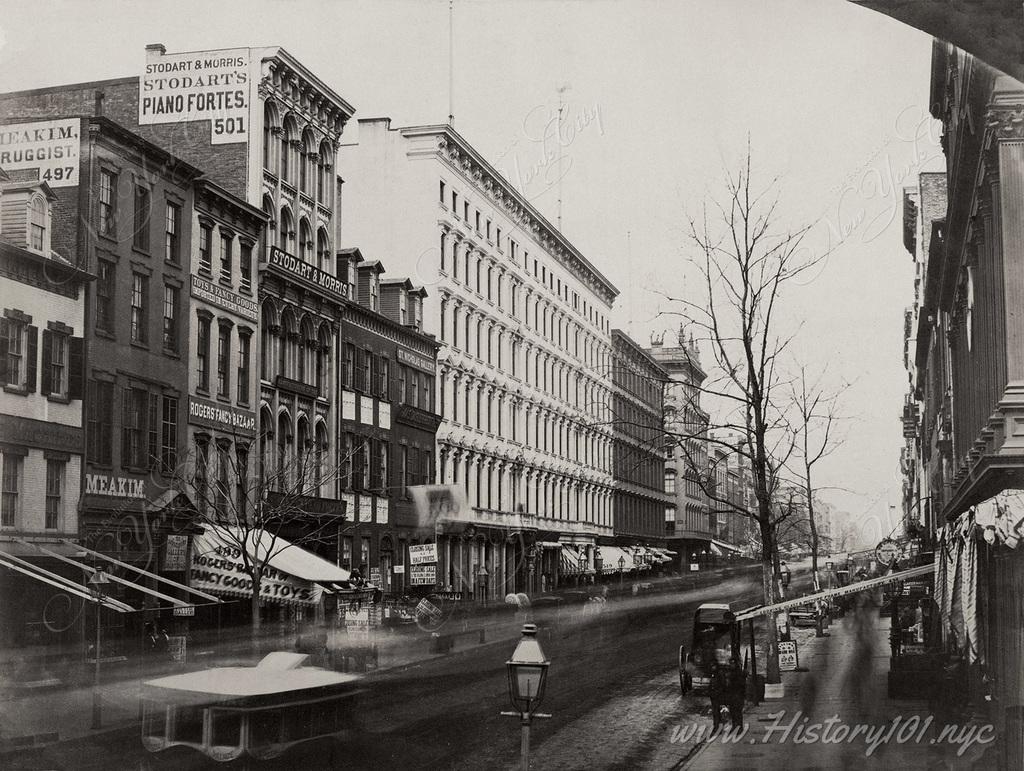
1855: Broadway and Broome Street
The East side of Broadway and Broome Street looking North, capturing the hum and activity of downtown Manhattan during a cold winter.
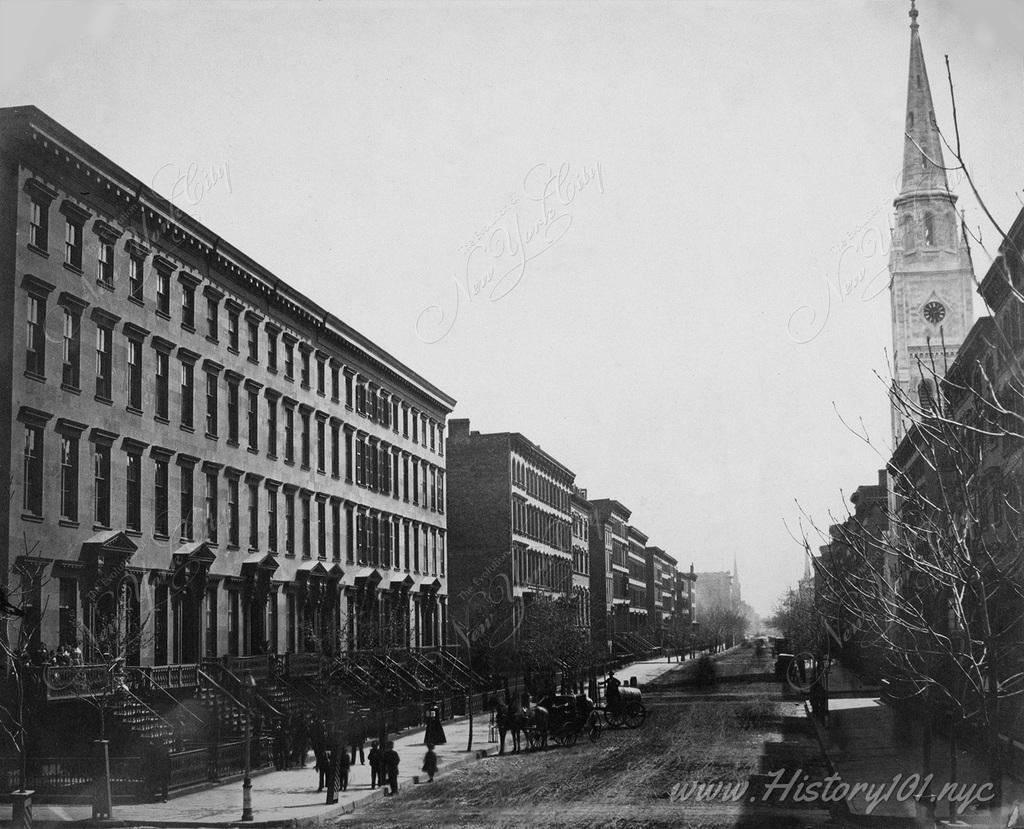
1855: Brownstones on Fifth Avenue
View of a residential neighborhood along New York's Fifth Avenue. Rows of single-family brownstones with grand front stoops line the wide corridor.
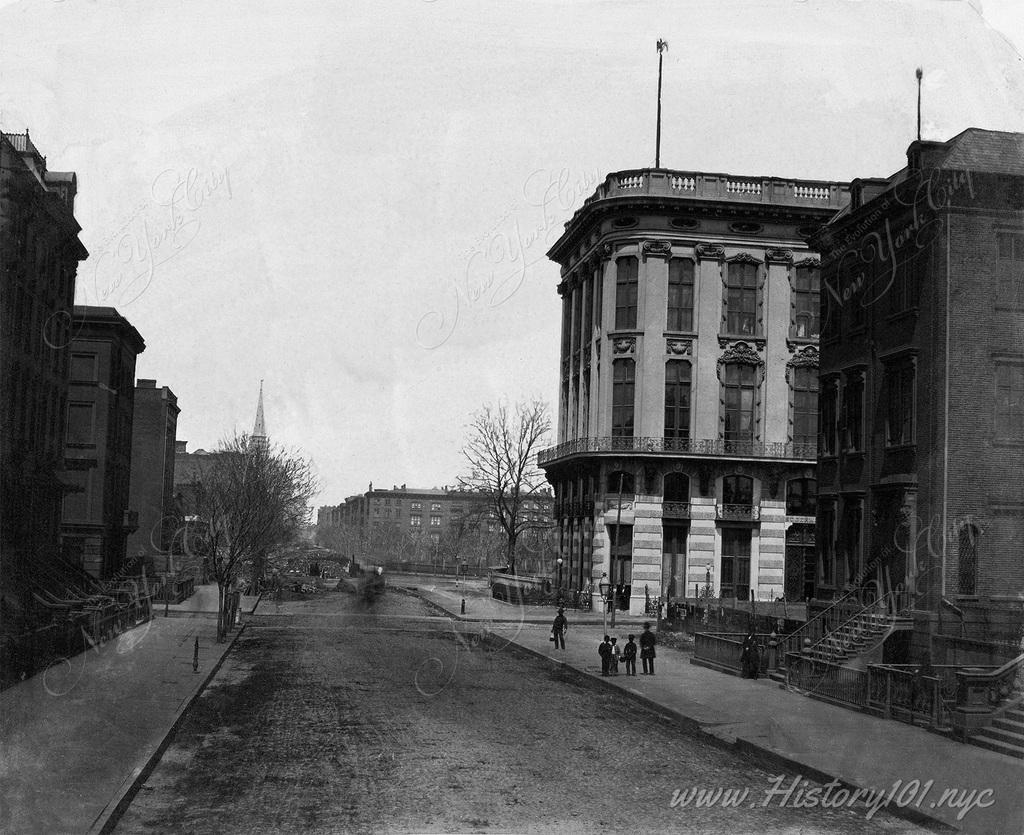
1855: St. Germain Hotel on Fifth Avenue
A view of the St. Germain Hotel on the North East Corner of 5th Avenue between 22nd and 23rd Streets (future site of The Flatiron Building).
Timeline of New York City: 1850-1860
1850: NYC's population soared to 550,394 from just 60,515 in 1800, a surge driven by industrialization, job creation, and a spike in immigration, with the city emerging as a key entry point for newcomers. This growth, fueled by economic opportunities and cultural diversity, marked the city's transformation into a bustling urban hub.
The urbanization of NYC, including city expansion, infrastructure improvements, and transportation development, further propelled this growth. Central Park's construction in 1858 epitomized this advancement, positioning the city as a future global metropolis and a cultural, economic, and social beacon.
1850: Opening as Tripler's Hall in 1850 and later known as Metropolitan Hall, the original Winter Garden Theatre quickly emerged as a cultural landmark in NYC. Offering a diverse array of shows, from variety acts to Shakespearean plays, the venue became a hub of theatrical vibrancy. Despite a devastating fire in 1854 leading to its reconstruction as The New York Theatre, the venue continued to gain prominence, reflecting NYC's dynamic cultural scene.
The current Winter Garden Theatre traces its origins to 1885 when it started as the American Horse Exchange, built by William C. Vanderbilt at 50th Street and Broadway. In 1896, architect William Albert Swasey transformed it into the "American Theatre," which later evolved into today's renowned Winter Garden Theatre. This transition from a commercial hub to a theatrical cornerstone highlights NYC's capacity for innovative urban adaptation and cultural evolution.
1850: New York City's population surged from about 97,000 in 1811 to over 500,000 by 1850, catalyzing the park movement led by advocates such as journalist William Cullen Bryant and landscape designer Andrew Jackson Downing. Through their editorials and writings, they underscored the urgent need for a large central park, a sentiment echoed by Mayor Caleb S. Woodhull's emphasis on the city's scarcity of green spaces, making park creation a pivotal political issue.
In response, Mayor Ambrose C. Kingsland, who took office in January 1851, proposed funding for a large park. By 1853, the site for Central Park was selected, initiating its development. Central Park became more than just a solution to overcrowding; it enriched NYC's social, cultural, and environmental fabric, establishing itself as an essential urban oasis.
1850: Launched by Harper & Brothers in New York City in 1850, Harper's New Monthly Magazine, later known as Harper's Magazine, quickly ascended as a premier American literary and cultural publication. Renowned for its high-quality content, it provided a platform for prominent writers, profoundly influencing American literature and culture. With a diverse range of content from serialized novels to essays on both domestic and international affairs, the magazine established a solid presence in literary circles and among a broad readership.
Harper's Magazine significantly shaped New York City's cultural and intellectual landscape. At the heart of the city's 19th-century publishing boom, it bolstered New York's reputation as a national center for publishing and journalism. Serving as a historical chronicle, the magazine captured and reflected evolving social, political, and cultural trends, weaving itself into the cultural fabric of both the city and the nation.
1850: Under the editorship of Gustav Adolf Neumann, the New Yorker Staats-Zeitung became the first German-language daily newspaper in the United States on January 26. Transitioning from a weekly to a daily publication, it marked a notable advancement in American journalism, serving the German-speaking community in New York City.
The New Yorker Staats-Zeitung was pivotal in fostering cultural cohesion and political advocacy among the city's substantial German immigrant population. Its contributions significantly shaped the social and cultural dynamics of New York City, reinforcing its status as a multicultural hub and reflecting its role as a central point for immigrant communities in the mid-19th century.
1850: John Wiley & Sons emerged as a pioneering publishing company specializing in engineering and science, establishing its prominence in New York City’s publishing sector since its inception in 1850. This focus not only marked the firm’s influence in academic fields but also set it apart from its contemporaries.
Enhancing New York City's literary and educational landscapes, John Wiley & Sons has become a vital resource for universities, professionals, and students, contributing significantly to the city’s intellectual expansion. Moreover, the success of the company has bolstered New York’s reputation as a major publishing hub, supporting the local economy and promoting broader economic growth.
1851: William Marcy "Boss" Tweed, elected as an alderman in 1851, quickly rose to prominence within Tammany Hall, NYC's Democratic political machine, by the late 1850s. By the mid-1860s, he led the infamous "Tweed Ring," engaging in corrupt practices like vote-buying, judicial corruption, and embezzlement from city contracts. Tweed's era profoundly affected NYC's political landscape through its pervasive corruption.
By the mid-19th century, NYC had emerged as the world's second-largest port after London, indicating its significant rise in global trade. The city's Jewish population reached around 10,000, facing minimal anti-Semitism, reflecting NYC's relatively tolerant atmosphere. Urban development included Manhattan's expansion up to 34th Street and Broadway being paved to Chambers Street, showcasing rapid infrastructural growth and transformation into a major metropolitan hub.
1851: The New York and Erie Railroad, spanning 440 miles from Piermont to Dunkirk, revolutionized transportation, linking NYC with the Great Lakes. This engineering marvel, among the longest U.S. railroads then, was spearheaded by Daniel Drew, James Fisk, and John B. Jervis. Its launch marked a pivotal moment in national transport infrastructure development.
Beyond facilitating travel, this railroad significantly impacted trade and communication between the East Coast and Midwest, driving economic growth and enhancing regional connectivity. It fostered social and cultural integration across the U.S., promoting national unity. For NYC, it was a key development, reinforcing its status as a commercial center and strengthening ties with diverse regions.
1851: The New York and Hudson River Railroad launched, connecting NYC to Albany from its East Broadway terminal. This marked a significant boost in the city's transportation, enhancing travel efficiency and economic ties within New York State. The rail line's introduction was instrumental in NYC's mid-19th-century growth, expanding its connectivity and economic stature.
NYC's rail infrastructure evolved further when the New York Central Railroad opened the first Grand Central Terminal in 1871, located at the site of today's terminal. This centralization of rail services was a major step in streamlining city transport. The iconic current Grand Central Terminal, unveiled in 1913, replaced its predecessor, becoming a symbol of the city's architectural and cultural legacy.
1851: Founded on September 18, The New York Times, initially the New-York Daily Times, marked a new era in American journalism. Created by Henry Jarvis Raymond and George Jones, it aimed to counter the era's sensationalist journalism with objective, balanced reporting. This launch signified a commitment to rigorous journalistic standards, revolutionizing news delivery.
The New York Times significantly reshaped New York City's media scene, setting benchmarks for fact-based reporting and neutrality, influencing peer publications. Beyond journalism, its role in public opinion and historical documentation has been pivotal. As a successful business, it enhanced NYC's economic status, cementing the city's reputation as a media and commerce hub.
1851: Founded by Isaac Merritt Singer and Edward Clark, Singer & Co. in New York City revolutionized the sewing machine industry. Their innovation significantly enhanced garment production efficiency, boosting the city's economy and creating employment opportunities, notably for women. This development played a key role in reshaping global fashion manufacturing and retail.
Also established in 1851 was Kiehl's pharmacy in East Village, New York City. John Kiehl's venture initially offered a unique mix of pharmaceutical and herbal products. Kiehl's evolution into a prominent skin care and cosmetics brand mirrors New York City's diverse and dynamic commercial sector, showcasing its influence in the evolving personal care and beauty industry.
1852: The American Geographical Society (AGS) is founded and establishes its headquarters in New York City, emerging as a leading organization in geographic knowledge and research. The AGS has significantly influenced the city's academic and cultural landscape, attracting scholars, explorers, and geography enthusiasts, and thereby enriching New York's intellectual environment.
The AGS's presence in New York City has been multifaceted in its benefits. It has become a pivotal hub for geographical information, aiding sectors like education, government, and commerce, and elevating the city as a beacon of knowledge and innovation. Moreover, its global engagement and educational initiatives have connected New York to worldwide networks of geographic exploration and discourse, amplifying the city's international cultural and academic stature.
1852: New York City introduced its first public bath on January 1, at 5 Centre Market Place, enhancing public health initiatives in its expanding urban landscape. Primarily catering to the immigrant and working-class populations who lacked proper home bathing facilities, this initiative was a key part of broader social reforms aimed at improving sanitation and curbing disease among the urban poor.
The establishment of public baths underscored the city’s commitment to improving resident living conditions by promoting personal hygiene and public health. These facilities addressed significant public health challenges associated with rapid population growth and tight living quarters, embodying the city’s progressive stance on urban welfare and public health policies in the mid-19th century.
1852: The YMCA (Young Men's Christian Association) was officially founded in New York City, following its initial establishment in London in 1844 and the opening of the first U.S. branch in Boston in 1851. The New York City YMCA quickly became a cornerstone for community support, offering a range of educational programs and social services aimed at improving the quality of life for young men in the bustling urban environment.
Since its inception, the New York City YMCA has expanded its mission to include support for families and children, becoming a vital part of the community's social fabric. It has been instrumental in promoting healthy living, lifelong learning, and fostering a sense of community through its numerous programs. This enduring presence highlights its pivotal role in shaping social welfare services in one of the world's most dynamic urban landscapes.
1853: New York City hosted the first U.S. World's Fair, the Exhibition of the Industry of All Nations, in 1853, showcasing global technological and industrial advancements. Held in the Crystal Palace, a vast cast iron and glass structure in present-day Bryant Park, the event symbolized progress and innovation. Designed by Georg Carstensen and Charles Gildemeister, the Crystal Palace attracted millions and bolstered New York's industrial prominence.
In the same venue, pivotal demonstrations took place, including Elisha Otis's safety elevator in 1853, enhancing future building designs, and Steinway & Sons' piano display in 1855, marking New York's ascendancy in manufacturing. Despite its destruction by fire in 1858, the Crystal Palace left a lasting legacy, inspiring future exhibition venues globally and cementing New York City's role in cultural and technological showcases.
1853: Launched by Frank Queen, the New York Clipper, also known as The Clipper, quickly rose to prominence as a key sports and entertainment periodical in the U.S. Its extensive coverage, ranging from theater and circus to sports, notably baseball, played a significant role in enriching New York City's cultural landscape. The Clipper's comprehensive reporting on baseball particularly helped establish the sport's popularity nationwide, marking its influence in sports journalism.
The Clipper's contribution extended beyond journalism; it became an indispensable historical record of 19th-century sports and entertainment. Its success enhanced New York City's publishing industry, reinforcing the city's stature as a major center for journalism and publishing. This, in turn, contributed to the city's economic and cultural growth, reflecting its dynamic and evolving nature.
1853: Founded by Henry Engelhard Steinway, Steinway & Sons rapidly transformed New York City's cultural and industrial landscapes. Originating in a modest Manhattan loft, the company set new standards in piano craftsmanship, blending acoustic excellence with artistic expression. Steinway pianos, celebrated for their quality, became integral to New York's thriving musical scene, gracing concert halls, theaters, and homes, and symbolizing the city's cultural sophistication.
The rise of Steinway & Sons also marked significant economic and technological advancements for New York City. The company's growth created diverse job opportunities, bolstering the city's status as a hub of industrial ingenuity and manufacturing. Globally, Steinway's reputation for top-tier pianos elevated New York City's international standing in cultural and artistic innovation.
1853: The expansion of horse-drawn omnibus routes in 1853, building on their initial introduction in 1832, marked a significant evolution in urban transport in New York City. Originally running from the Battery to Bleecker Street along Broadway, these omnibuses extended their reach citywide to meet the growing demand for efficient travel. This widespread adoption offered a more reliable and comfortable alternative to traditional transport methods, marking a shift towards communal transportation.
The success of the omnibus service had a profound impact on the city's daily life and extended beyond mere transportation. The expanded routes enhanced citywide mobility for work, shopping, and leisure, significantly influencing urban development. This period was crucial in establishing a more organized, interconnected transport network, laying the groundwork for future innovations such as streetcars and buses, thereby boosting the city's socioeconomic growth.
1853: Architects Frederick Law Olmsted and Calvert Vaux envisioned Central Park as a natural haven within New York City's urban landscape. Their 1853 proposal aimed to transform a rocky, swampy area, including Seneca Village, into a green space for enhancing public health and well-being. The design featured harmonious landscapes, walking paths, and recreational zones. This undertaking was not just about creating a park; it involved reimagining urban land use and acknowledging the significance of green spaces in city life.
The construction of Central Park commenced soon after the proposal, leading to the displacement of Seneca Village residents. Opening in 1858, the park emerged as a beloved urban sanctuary and a milestone in urban planning. Its establishment played a pivotal role in NYC's history, symbolizing a shift in urban design philosophy and underscoring the importance of accessible natural areas for the community's welfare.
1853: New York City opened the United States' first public telegraph office, a groundbreaking development largely thanks to Samuel Morse, inventor of the telegraph system in the 1830s. This innovation, including Morse code, enabled fast long-distance message transmission, heralding a new communication era. The telegraph office's establishment allowed rapid cross-country messaging, revolutionizing communication practices.
This telegraph introduction profoundly impacted New York City's commerce and communication sectors, revolutionizing business transactions and information sharing, thus accelerating the city's evolution into a commercial and technological hub. Today, NYC remains a key player in communication technology, with industry leaders based there. Samuel Morse's legacy in communication technology endures, epitomizing his crucial role in modern telecommunication's genesis.
1853: Franconi's Hippodrome, which opened in New York City on May 2, marked a significant expansion in the city's public entertainment landscape. Offering a diverse array of performances such as equestrian shows and circuses, this venue became a key cultural hub. It catered to the growing leisure interests of a diverse urban population, enhancing the city's cultural offerings during a period of rapid expansion.
As a landmark for public entertainment, Franconi's Hippodrome significantly influenced New York City's cultural evolution. It symbolized the era's shift toward more accessible entertainment options for the masses and played a crucial role in transforming the social and cultural dynamics of the city during the mid-19th century.
1853: Stanford White, a notable American architect, was born on November 9, in New York City. He became a key figure in the Beaux-Arts movement and was instrumental in shaping the architectural identity of America, particularly in the late 19th and early 20th centuries. White’s designs contributed significantly to the architectural landscape of New York City, including major landmarks and building projects.
Among his most famous works in New York are the Washington Square Arch and significant architectural contributions to the Columbia University campus. These designs not only enhance the city’s visual appeal but also contribute to its rich cultural heritage. White’s impact on New York City’s architecture remains profound, underscoring his role in defining the aesthetic of an era and leaving a lasting legacy on the city's skyline.
1854: New York City was struck by a cholera epidemic in 1854, during a global pandemic, claiming approximately 2,509 lives. This severe outbreak was exacerbated by the city's inadequate sanitation, including poor sewage systems and contaminated water sources, highlighting significant public health challenges in the rapidly growing metropolis.
Prompted by this crisis, substantial reforms in public health and urban infrastructure were initiated. Efforts focused on improving sanitation through enhanced sewage systems and cleaner water supplies, which were pivotal in preventing future disease outbreaks. These improvements not only bettered health conditions but also laid the foundation for modern public health practices in New York, marking a crucial turning point in the city's approach to healthcare and urban planning.
1853: Authorized by the US Congress, the US Assay Office was established at the old New York City Post Office to manage the influx of gold from the California Gold Rush. This facility focused on assaying, a process critical for determining the purity and quantity of precious metals, essential due to the significant amounts of gold processed at the time.
The introduction of the US Assay Office bolstered New York City’s status as a financial hub, enhancing its role in the testing and valuation of precious metals. This development not only spurred local economic growth by boosting trade and commerce but also cemented the city's position as a pivotal player in both national and international financial markets.
1854: Manhattan's Academy of Music, which opened in 1854 at East 14th Street and Irving Place, quickly became a cultural landmark in New York City. The 4,000-seat venue was praised for its acoustics but received criticism for its design and seating arrangements from The New York Times. It became a social hub for the city’s elite, including the Belmonts, Beekmans, and Stuyvesants, under the patronage of Mrs. Astor, with its opera season becoming a key social event.
The Academy’s refusal to grant opera boxes to the 'nouveau riches,' including the Vanderbilts, Morgans, and Goulds, led to a significant cultural shift. In response, Alva Vanderbilt spearheaded the opening of the Metropolitan Opera House in 1883 at Broadway and 39th Street, which quickly overshadowed the Academy. By 1886, unable to compete, the Academy ceased opera presentations, shifting to vaudeville before its demolition in 1926.
1854: In response to the Kansas-Nebraska Act, the Republican Party was founded in 1854, quickly becoming a significant political force opposed to the expansion of slavery and championing the principles of free soil, labor, and men. This establishment marked a pivotal shift in American politics amid the intensifying debate over slavery. Contrary to popular belief, the party's first national convention was not in New York City but held in Philadelphia in 1856.
While New York City did not host the Republican Party's inaugural convention, the party's strong anti-slavery stance significantly influenced the city's political and social fabric. As a political hub, the city was deeply engaged in the national discourse on slavery. Over time, the party's focus shifted from abolition to embracing conservative values and limited government, reflecting and shaping New York's dynamic socio-political landscape.
1854: Initiated by John Jacob Astor in 1839 and officially opened in 1854, the Astor Library became a cornerstone of New York City's cultural framework. Located in the East Village and designed by Alexander Saeltzer, it was envisioned by Astor and educator Joseph Cogswell as a public research library with a vast array of non-circulating reference materials. This institution significantly advanced public access to literature, playing a pivotal role in the city's intellectual enrichment.
In 1895, the Astor Library merged with the Lenox Library and the Tilden Foundation to form the New York Public Library, profoundly expanding the resources available to the public. This merger not only enhanced New York City's cultural and intellectual landscape but also established a vital legacy that continues to benefit the community and scholars globally, marking a significant evolution in public access to educational resources.
1854: The US Assay Office, which officially opened in New York City on October 10, was established to manage the assaying and smelting of gold from the California Gold Rush. Strategically located, the facility played a key role in securely processing vast amounts of gold, supporting the burgeoning financial sector of mid-19th century New York.
Its establishment was pivotal in enhancing New York City’s stature as a major financial center. The Assay Office facilitated the flow of gold, bolstering critical industries such as finance and jewelry. This not only fueled the city's economic growth but also integrated it more tightly with national and international markets, confirming its essential role in the global economic system.
1854: Incorporated in New York City on December 30, the Pennsylvania Rock Oil Company was the first oil company in the United States, signaling a key moment for the American oil industry. This development positioned the city at the forefront of the burgeoning sector, coinciding with increasing interest in petroleum products and advances in oil extraction technologies.
The presence of the Pennsylvania Rock Oil Company underscored New York City's role as a significant financial and business hub, attracting attention and investment to the emerging oil industry. By hosting the nation’s inaugural oil company, New York City not only bolstered its economic diversity but also reinforced its reputation as a center for industrial innovation and commerce, significantly impacting its mid-19th-century economic landscape.
1855: Fernando Wood, closely associated with Tammany Hall, began his first mayoral term in New York City in 1855, having been elected the previous year. His administration, covering two non-consecutive terms from 1855 to 1858 and again from 1860 to 1862, was notable for substantial urban development and political controversies that mirrored the complex dynamics of mid-19th-century city politics.
Wood's tenure provides insights into the intricate political scene of New York City during a transformative period, including the onset of the Civil War. His leadership was marked by significant infrastructural growth alongside issues of corruption and patronage, which profoundly influenced the city’s urban and socio-political landscape.
1855: On May 5, the New York State Commission on Emigration assumed the lease of Castle Garden, located at the southern tip of Manhattan, now known as Castle Clinton. This transition marked the establishment of America’s first official immigration station. Previously serving as a fort and entertainment venue, Castle Garden was repurposed to manage and process the large influx of immigrants arriving in New York City.
During its operation as an immigration station from 1855 until 1890, Castle Garden welcomed approximately 8 million immigrants. This facility was instrumental in shaping New York City’s demographic landscape, serving as the primary entry point for immigrants before the opening of Ellis Island. Its role as an immigration processing center significantly contributed to the cultural and economic development of New York City, reinforcing its status as a pivotal gateway for new Americans.
1855: James E. Kelly, an American sculptor renowned as the "Sculptor of American History," was born on July 30, in New York City. He gained recognition for his detailed bronze sculptures of American historical figures and events, contributing significantly to the country's artistic heritage. Kelly passed away in 1933, leaving behind a legacy of important works that capture pivotal moments in American history.
Kelly's sculptures are prominently displayed in various public spaces and museums throughout New York City, enhancing its cultural landscape. His artistic contributions not only beautify the city but also serve educational purposes, helping to connect viewers with the historical narratives of the United States. This integration of art and history through Kelly’s works has helped cement New York City's status as a key center for historical and cultural arts, enriching both its cultural appeal and educational resources.
1855: Castle Garden, located at the southern tip of Manhattan and now known as Castle Clinton, officially opened as the first U.S. immigrant receiving station on August 1. This transition marked a significant chapter in American immigration history, with the facility initially serving as a fort, then an entertainment center, and finally a gateway for millions of immigrants entering the United States. Castle Garden continued its operations as an immigration station until the opening of Ellis Island in 1892.
During its operation, Castle Garden processed approximately 8 million immigrants, playing a crucial role in shaping the demographic and cultural landscape of New York City. It's establishment as an immigration processing center contributed significantly to the city's transformation into a diverse and vibrant metropolis. The station facilitated the integration of countless immigrants into American society, significantly impacting New York City's economic and social development.
1855: Washington Irving, born on April 3, 1783, in New York City, profoundly influenced American literature with his story "Rip Van Winkle." Published in 1819, this work reflects cultural and economic shifts of his era, set in the Catskill Mountains around the American Revolutionary War. The story, depicting deep societal changes, is a pivotal piece of American folklore, showcasing Irving's ability to weave historical themes with imaginative storytelling.
This narrative not only enhanced Irving's reputation but also cemented New York City’s status as an early literary hub. Furthering this legacy, George Frederick Bristow's opera adaptation of "Rip Van Winkle," which premiered in New York on September 27, 1855, marked the city as a significant cultural center, reinforcing its national importance in the arts.
1856: Land acquisition for Central Park began in 1856, setting the stage for its official establishment the following year. Renowned landscape architects Frederick Law Olmsted and Calvert Vaux were chosen in 1857 to design this iconic green space. Simultaneously, NYC Mayor Fernando Wood and Street Commissioner Joseph S. Taylor took roles as its first Commissioners, steering early development efforts.
The realm of public art also saw significant additions in 1856 with the unveiling of the equestrian statue of George Washington in Union Square, crafted by Henry Kirke Brown. In 1857, the Worth Monument, an obelisk honoring General William Jenkins Worth, was erected near Madison Square. These monuments highlight New York City’s dedication to commemorating historical figures, enriching its cultural and historical fabric.
1857: Founded by 13 architects, the American Institute of Architects (AIA) in New York City aimed to elevate architectural standards and education in the U.S., marking a significant step in the field's professionalization. The AIA's inception was a pivotal moment, advancing architecture nationwide.
It's establishment profoundly impacted New York City's architectural scene. The AIA's emphasis on professional standards and architectural excellence significantly shaped the city's building designs. Additionally, its focus on educational and discourse initiatives reinforced New York City's position as a hub of architectural innovation and urban planning leadership, significantly influencing its iconic skyline and urban development.
1857: Formed in 1845, the NYPD was one of the earliest U.S. police forces to develop detective functions, a response to increasing organized crime in neighborhoods like Five Points, dominated by gangs such as the Dead Rabbits and the Bowery Boys. This era's rise in criminal activity drove advancements in police methods, particularly in investigative techniques, shaping modern law enforcement practices.
The NYPD's pioneering detective work significantly impacted law enforcement across rapidly growing New York City. Thomas F. Byrnes, a notable NYPD detective and later Police Chief, though often miscredited with the capture of "Napoleon of Crime" Adam Worth, was instrumental in refining investigative strategies. The department's evolution, especially in detective practices, influenced nationwide policing models, positioning the NYPD as a forerunner in urban law enforcement and crime investigation.
1857: On March 23, Elisha Otis installed his first passenger elevator at 488 Broadway in New York City. This installation showcased his safety invention that included an automatic brake which would stop the elevator from falling if the hoisting ropes failed. This innovation marked a significant advancement in elevator technology, proving its safety and efficiency in public demonstrations.
The successful implementation of Otis's elevator at 488 Broadway revolutionized architectural design, enabling the construction of taller buildings and transforming New York City's skyline. This technological breakthrough not only facilitated the city's vertical expansion but also played a crucial role in shaping its future as a leading global architectural and economic center, supporting its development into the skyscraper-rich metropolis known worldwide today.
1857: New York City witnessed the Police Riot in June 1857, a pivotal conflict between the Metropolitan Police, backed by the Republican state legislature, and the Municipal Police, aligned with Tammany Hall's Democrats. Peaking around June 16, this clash underscored deep-rooted political rivalries, as both forces engaged in violent street battles.
This riot profoundly influenced NYC's law enforcement and governance, exposing severe political corruption within police ranks and leading to the Municipal Police's dissolution. The Metropolitan Police subsequently became the primary policing authority, signifying a major shift in the city's law enforcement approach. This crucial event catalyzed reforms and laid the groundwork for modern policing in New York, marking a defining moment in its intricate political and social history.
1857: Beginning on July 4, the Dead Rabbits Riot erupted in Lower Manhattan's Five Points, a hub of immigrant life and poverty. This multi-day upheaval, marked by fierce clashes between the Dead Rabbits, an Irish-American gang, their rivals the Bowery Boys, and law enforcement, reflected the era's intense social strife in New York City.
This conflict exemplified the mid-19th century's social and economic challenges, highlighting immigration issues, ethnic tensions, and the working class's struggles. It emphasized the need for better conditions for immigrants and revealed flaws in municipal governance and policing. Significantly impacting New York City's methods of addressing social unrest and promoting community integration, the Dead Rabbits Riot became a pivotal chapter in the city's intricate historical tapestry.
1857: The Panic of 1857, beginning in August, was a major financial crisis with global repercussions, severely impacting New York City's economy. Triggered by the railroad industry's overexpansion, agricultural price drops, and major bank collapses, this crisis led to widespread unemployment, bank failures, and a significant decline in commodity prices in New York City, a pivotal financial center.
This economic turmoil prompted criticism of President James Buchanan's administration, particularly for insufficiently addressing the crisis's root causes. The downturn affected various sectors in New York City, notably the commodities market. Despite attempts to stabilize the financial system, the Panic of 1857 underscored the need for robust financial policies and regulations, profoundly influencing New York City's economic landscape and emphasizing the importance of financial stability.
1857: The First American Chess Congress was held in New York City, initiated on October 6, and concluded with Paul Morphy winning on November 10, 1857. Hosted by the American Chess Association, this event marked the first significant chess tournament in the United States, drawing attention to the intellectual sport and showcasing emerging American chess talent.
The congress's successful execution in New York City underscored its emerging role as a hub for cultural and intellectual activities, boosting its cultural prestige. By facilitating this pivotal chess event, New York enhanced its appeal as a venue for significant intellectual gatherings, contributing to its reputation as a diverse and culturally rich metropolis. This event also played a crucial role in popularizing chess across the country, establishing a legacy of intellectual sports in America.
1858: Central Park's groundbreaking design, the "Greensward Plan" by Frederick Law Olmsted and Calvert Vaux, was selected, revolutionizing urban park planning. This innovative design, chosen from 33 entries, featured separate circulation systems for pedestrians, horse riders, and vehicles, concealing commercial traffic in sunken roadways. Envisioned as a naturalistic urban retreat for all social classes, the park stretched 2.5 miles long and 0.5 miles wide, becoming a green oasis in Manhattan.
Central Park's phased development began shortly after, with its first section, the Lake, opening in 1858. Over the next 15 years, the park's construction, initially estimated at $5 million, escalated to $14 million, reflecting its scale and ambition. Central Park's completion significantly enhanced New York City's environmental quality and social landscape, marking a key evolution in urban public space design.
1858: The Saturday Press, initiated by Henry Clapp Jr., emerged as a transformative force in New York City's literary scene starting in 1858. Renowned for its bohemian and avant-garde content, this weekly newspaper rapidly gained prominence, providing a vital platform for progressive writers and poets like Walt Whitman, and thereby reshaping contemporary literature.
Its debut significantly impacted New York City's cultural fabric, challenging literary conventions and nurturing a community of artists and intellectuals. The Saturday Press not only mirrored but actively influenced the dynamic cultural atmosphere of mid-19th century New York City, affirming its role as a center for artistic and intellectual progress, and enriching the city's cultural and historical legacy.
1858: Founded in 1844 in Alabama by Henry, Emanuel, and Mayer Lehman, Lehman Brothers initially focused on cotton trading. By 1858, the firm expanded to New York City, adapting to the city's rising status as a financial epicenter. This move marked a strategic shift from commodities to a broader financial services scope, shaping the firm's future trajectory. The firm declared bankruptcy in 2008, marking a significant moment in global financial history and ending its 164-year legacy.
Lehman Brothers' expansion into New York City significantly influenced the city's economic landscape. Transitioning to a comprehensive financial services firm, it played a key role in establishing New York as a global financial hub. Beyond financial contributions, Lehman Brothers engaged in cultural and philanthropic activities, bolstering the city's growth and employment, and cementing its reputation as a major center for commerce and finance, until its downfall in 2008.
1858: Established to tackle urgent public health challenges like disease outbreaks and poor sanitation, the New York City Health Department's formation, commonly dated to 1858, was driven by physicians and public health advocates, including Dr. Stephen Smith, Dr. John Griscom, and Dr. John Swinburne. Their recognition of the need for a unified public health strategy was pivotal in addressing the city's health issues.
The department's mandate involved controlling communicable diseases, regulating public spaces, and enhancing hygiene and cleanliness. Through its significant efforts, it considerably reduced disease incidence and improved the overall health of the city's residents. These early actions by the Health Department laid the groundwork for contemporary public health practices, marking it as a crucial institution in ensuring the health and safety of New Yorkers, and setting a model for future public health initiatives.
1858: Founded by Rowland Hussey Macy at 14th Street and 6th Avenue, Macy's quickly ascended in the retail world with its pioneering strategies, beginning its journey in 1858, contrary to the commonly believed year of 1856. This inception marked a significant chapter in American retail history, setting the stage for what would become a global retail empire.
Over the decades, Macy's growth and cultural impact were symbolized by its iconic red star logo, inspired by Macy's own tattoo. The brand significantly shaped cultural traditions, most notably initiating the Macy's Thanksgiving Day Parade in 1924, now a staple in NYC culture. The 1902 opening of its flagship store at Herald Square, one of the world's largest, cemented Macy's status as a major force in the retail sector and a key element of NYC's rich cultural tapestry.
1858: On August 2, New York City alongside Boston, marked a significant advancement in postal service history by installing the first street mailboxes. This innovation allowed residents and businesses to send mail conveniently without the need to visit a post office, streamlining the process and enhancing accessibility for all users.
The introduction of street mailboxes in New York City played a crucial role in modernizing its communication infrastructure. It facilitated quicker and more efficient mail handling, which was essential for the city's burgeoning economic activities and growing population. This development not only improved daily communications but also supported New York City's continuous growth as a leading urban center, reflecting its commitment to adopting innovative solutions to improve urban life.
1858: Theodore Roosevelt, the 26th President of the United States, was born on October 27, in New York City. His presidency, notable for progressive reforms and strong leadership, lasted from 1901 to 1909. Roosevelt also received the Nobel Peace Prize in 1906 for his role in mediating the Russo-Japanese War, further cementing his legacy as a key figure in early 20th-century global politics.
Roosevelt's connection to New York City greatly enhanced its historical narrative, illustrating the city's influence on national leadership. His vigorous public life and policies mirrored the dynamic and progressive spirit of New York City, bolstering its reputation as a breeding ground for influential leaders and reformers. His birthplace and childhood home in New York remain significant historical sites, reflecting his enduring impact on the city's cultural and political heritage.
1858: The Young Women's Christian Association (YWCA) was officially established in New York City on December 15. It was founded to provide support, particularly in terms of safe housing and employment opportunities, to the increasing number of young women moving to the city. The YWCA's mission was to offer a protective community for women who were often experiencing urban life for the first time, making it a pioneer in advocating for women's welfare in an expanding urban landscape.
The establishment of the YWCA in New York City played a critical role in the city's socio-economic development. By helping women gain economic independence and social integration, the YWCA contributed to the shaping of New York's workforce and cultural milieu. This integration not only supported the individual lives of countless women but also bolstered the city's overall economic growth and cultural diversity, reflecting New York’s progressive approach to social reform and community support.
1859: Cooper Union for the Advancement of Science and Art, founded by Peter Cooper, broke new ground in higher education in New York City. Offering free, world-class education in art, architecture, and engineering, it welcomed students regardless of social status, wealth, gender, or race, pioneering inclusive access to education. This institution was one of the first in the U.S. to embrace such a broad admissions policy, including both women and men of all races.
Additionally, Cooper Union emerged as a significant cultural and political venue, notably with its large meeting room in the Foundation Building. This room hosted a critical 1860 speech by Abraham Lincoln, organized by the Young Men’s Republican Union, which greatly enhanced Lincoln's national profile and was instrumental in his election as President. This event exemplified Cooper Union's substantial impact on the U.S. political landscape and its role in shaping American history.
1859: The Weekly Anglo-African, initiated by Thomas Hamilton and his brother Robert in New York City, became a seminal publication for the African American community. It facilitated crucial discussions on abolition, civil rights, and culture, featuring insights from leading African American intellectuals and activists, thereby shaping discourse during the pre-Civil War era.
The magazine's impact extended beyond journalism, amplifying African American voices on pivotal issues and influencing social and political movements. Its focus on racial equality and civil rights significantly affected public opinion and contributed to New York City’s cultural richness. The Weekly Anglo-African underscored the city’s role as a hub for progressive thought and activism, making a lasting mark on its historical and cultural narrative.
1859: Charles Ebbets, an influential American sports executive, was born on October 29, in New York City. He is best known for his role as co-owner of the Brooklyn Dodgers from 1897 to 1902. His tenure with the team marked the beginning of a significant era in New York sports history, contributing to the development and popularization of baseball in the city.
Ebbets' legacy is closely tied to Ebbets Field, a ballpark he commissioned that opened in 1913 in Brooklyn and served as the home for the Dodgers until 1957. This stadium not only became a beloved landmark but also helped to foster a strong community identity and spirit among Brooklyn residents. His contributions to the city's sports culture extended beyond baseball, enhancing New York City's status as a vibrant hub for sports and entertainment.
1859: Henry McCarty, better known as Billy the Kid, one of the most iconic outlaws and gunfighters of the American Wild West, is widely believed to have been born in New York City on November 23, 1859. While there is some debate regarding the specifics of his birthplace and date, this association places him among the many Americans who moved from the East to the expanding frontiers of the West during the 19th century.
Billy the Kid’s early life in New York City highlights the diverse and transformative journeys of individuals during America’s westward expansion. His move from the urban East to the rural West exemplifies the migration patterns that shaped the socio-economic and cultural landscapes of the United States during that era. This connection also reflects on New York City’s role as a starting point for many who would go on to play significant roles in American history, emphasizing the city’s impact on national development beyond its borders.
1859: Edwin Drake drilled the first commercial oil well near Titusville, Pennsylvania, initiating the modern petroleum industry and profoundly influencing the American economy. While New York City was not a production hub, this event elevated its status as a pivotal financial center for the burgeoning oil industry. The city became instrumental in facilitating key investments and transactions that significantly contributed to the industry's growth.
John D. Rockefeller founded Standard Oil in 1870, quickly establishing it as a dominant force in the oil sector through innovative strategies. Rockefeller's presence in New York City spurred substantial philanthropic efforts and urban development, including landmarks like Rockefeller Center and Riverside Church. His influence reshaped not only the oil industry but also the city's cultural and architectural landscape, securing his legacy as a pivotal figure in New York's history.
1859: Brooklyn's population soared from around 48,000 in 1840 to nearly 280,000 by 1859, triggering a pressing need for public parks to address the dense urban environment. Walt Whitman and others advocated for these green spaces, leading to the New York State Legislature's establishment of the Brooklyn Board of Park Commissioners in 1859, aimed at enhancing the city's recreational infrastructure.
The Board proposed Prospect Park in 1860, with its design and development assigned to Frederick Law Olmsted and Calvert Vaux in 1865. This duo, celebrated for their Central Park creation, imparted their distinct landscape vision to Prospect Park, often regarded as a quintessential representation of their design ethos. This park not only met the city's demand for public spaces but also epitomized landscape architecture, significantly enriching Brooklyn's urban landscape.
